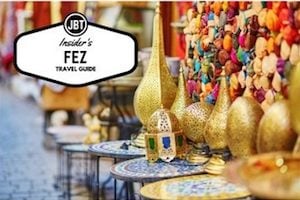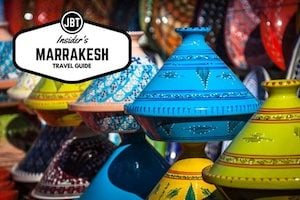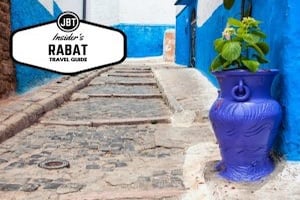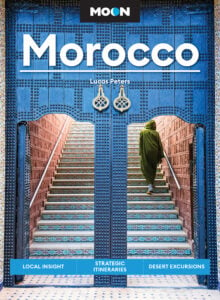
In Essaouira, there is a cooking class unlike any other in Morocco. Khadija’s Kuzina, located just outside the medina, is an experience that is so much more than just learning something about cooking Moroccan cuisine. It’s a visit into the hearts of the proprietors, Lahoussaine (a.k.a. “Hussein”) El Faded and Khadija El Jadiri, and an intimate preparation of dinner in their home rather than in a commercial kitchen.
Over mint tea, Hussein explained the background of their lives and the cooking class. Hailing from the tiny village of Ait Diba in the mountains near Essaouira, where they still live part-time, the couple has been supporting the Peace Corps since 2003. They facilitate projects by helping the Corps gain the trust of villagers, as well as by hosting volunteers in their home, some for as long as 3 years. They have a passion for cultural exchange and have maintained friendships with former volunteers and past class participants from all over the world. Once, hearing that the newly-married daughter of a volunteer was coming to visit, Hussein and Khadija arranged a traditional Moroccan wedding celebration in their village, attended by all of the residents. In addition, they consider themselves activists and work on many other projects promoting development and gender equality in Morocco.
Why would such a busy couple want to add to their workload with a cooking school? Simply put, Hussein said, they needed the extra money. Khadija has formal training as a chef and they considered opening a restaurant. But their Western friends, having enjoyed Khadija’s cooking for years, encouraged her to share her knowledge with tourists instead. The benefits of this also include more flexibility for their working hours and a lot less stress. Khadija’s Kuzina has garnered a consistent 5-star rating on Trip Advisor.
Khadija’s teaching style is relaxed and informal. Eight of us gathered in her spacious kitchen around a table covered with bowls of vegetables and spices. The menu included couscous with chicken, tfaya (caramelized onions, raisins and spices), gravy, garbanzo beans, fried almonds, tomato-and-pepper salad and Khadija’s Pizza – her own recipe of small freshly-made breads stuffed with a mixture of carrots, onions, raw garlic and spices.

Rather than explaining every detail, Khadija demonstrated what to do each step along the way – grating carrots or chopping onions – and then we got to work. Ingredients such as rose water, raw garlic, and the slowly-cooking chicken and gravy added wonderful aromas to the room as we took turns kneading bread and fluffing couscous. We tasted smen, a fermented butter that smells like blue cheese; even my herring-loving, Swedish compatriots were wary. A small amount was added to the stewing chicken for a subtle flavor enhancement. We were worried, but Khadija knows what she’s doing.
Unlike many Moroccan cooking classes where each participant makes their own food, we prepared one enormous meal to be eaten family style. Working together to create this meal made a very friendly, social atmosphere, which is just the way it should be in a class like this. As Hussein explained it, money comes and goes; love and sharing are the most important things in life.
The kneaded bread was split into a dozen or so small pieces. We all flattened the small balls and then Khadija cooked them on a baking tray on top of the oven. Then we sliced them open like English muffins and filled them with the briefly-sautéed carrot, garlic and rose water mixture. Each was then cut in quarters and piled high on a plate. Khadija’s Pizza was ready to eat!
When the chicken was cooked, and the couscous had been steamed and fluffed 3 times, Khadija quickly browned the meat in the oven and then we all assembled the half-meter-wide plate. First the couscous was laid down and smoothed. Then gravy and beans were poured around it. Next, pieces of chicken were laid on the couscous and between the pieces, big scoops of tfaya were covered with decorative stars made from the freshly-fried almonds. We poured a bit of fragrant argan oil onto the salad. All was brought out to their sitting area and we gathered around the table for a delicious feast.
Just as we sat down to dinner, we heard the cry of a baby. Khadija pardoned herself. The baby needed her attention. Over dinner, Hussein told us the story of their marriage, how they married in 1995 and after several years of unsuccessfully trying to have a baby, adopted their son Yassin, now a teenager. In 2017, Hussein explained, a miracle happened. Khadija went to the doctor feeling ill and discovered that she was pregnant. In December, their son Amir was born. At the time of this writing, he is a happy, healthy, 3-month old baby. Talking about Amir’s birth, Hussein said, “Life rewards you when you give love.”

If there is one impression I took out of my time at Khadija’s Kuzina, it was that this couple is full of love and share it freely.
Classes at Khadija’s Kuzina aren’t usually as big as the one I attended – 3 to 4 people is the norm and you should allow 3 hours at their home. Like most Moroccan cooking classes, the first person to register for a class gets to pick the menu. Unlike most Moroccan cooking classes, this one is held in the evening. Be sure to ask them to prepare “Khadija’s Pizza.” It’s an amazing party dish that you’ll want to try at home!
To contact Hussein and Khadija, you can either email them at khadijaskuzina@gmail.com, or message them on their Facebook page, Khadija’s Kuzina.
About the Author
 Since retiring in late 2016 from a career in IT, Mike Bernhardt has been visiting other cultures and writing about what he finds. When he’s not traveling he cooks international cuisine, plays his guitar, and on rainy days assists itinerant earthworms to cross the road.
Since retiring in late 2016 from a career in IT, Mike Bernhardt has been visiting other cultures and writing about what he finds. When he’s not traveling he cooks international cuisine, plays his guitar, and on rainy days assists itinerant earthworms to cross the road.
You can read about his adventures at travelingwithmikeandyvonne.com.








